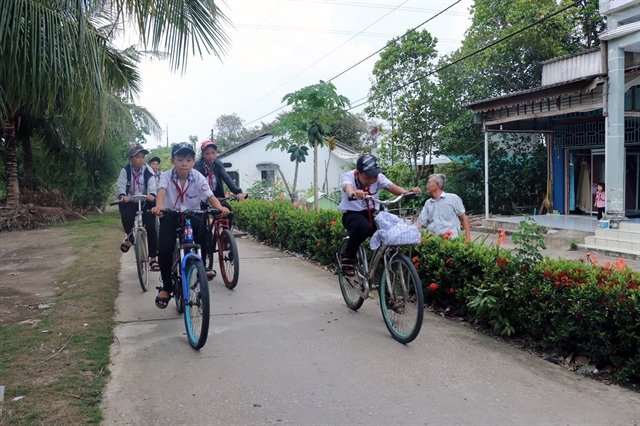 Society
Society


|
| A rural road in Kiên Giang Province’s Vĩnh Thuận District was paved as part of the National Target Programme on New-Style Rural Area Building. — VNA/VNS Photo Lê Huy Hải |
BẾN TRE — Nearly 50 per cent of the country's communes have met the standards of "new-style" rural areas, according to officials.
Speaking at a meeting in Bến Tre Province on June 25, Trần Thanh Nam, deputy minister of Agriculture and Rural Development, said the National Target Programme on New-Style Rural Area Building has completed all targets set for the 2016-20 period, one year earlier than scheduled.
Đồng Nai, Nam Định and Bình Dương provinces and Đà Nẵng City are the first in the country to have all of their communes meet the 19 criteria set under the programme.
The criteria are related to infrastructure, irrigation, electricity, environment, income, education, healthcare, social security and culture.
In Đồng Nai, all 133 communes have met the criteria. Last year, the average income per capita in rural areas was VNĐ51.59 million (US$2,210), up 18.1 per cent against 2016.
Nguyễn Thái Hạ, deputy director of the Đồng Nai Department of Planning and Investment, said the province had focused on investing in rural areas in the 2008-18 period.
The state budget investment for infrastructure in rural areas in Đồng Nai accounted for nearly 65 per cent of the province’s total budget spent in the period, he said.
Đà Nẵng has spent more than VNĐ513 billion ($22 million) for the programme from 2013 to 2020.
Of the figure, VNĐ283.4 billion is from the city budget, VNĐ122.6 billion from the district budgets, and the rest are from local residents.
The city has used the money to upgrade commune-level roads and rural roads, irrigation works in rice farming areas, electricity supply systems, cultural houses, sport playing grounds, schools, toilets and waste treatment facilities.
The city has also helped farmers restructure their agricultural production and set up farming models that use advanced techniques.
Nam said the country mobilised VNĐ851.38 trillion ($36.55 billion) from various sources for the programme in 2011-15 and VNĐ900.49 trillion ($38.68 billion) in 2016-18.
The country is expected to mobilise VNĐ367.86 trillion ($15.8 billion) for the programme this year. Of the figure, more than 22 per cent will come from companies and communities.
Despite good results, the programme has faced several problems, including mobilising a sufficient amount of money.
In the past, most funds came from the State budget and loans. The number of companies participating in the programme also remains limited.
Nguyễn Văn Hiếu, deputy dinister of Planning and Investment, said that investment mechanisms would be simplified so that more people can participate in the programme. — VNS




